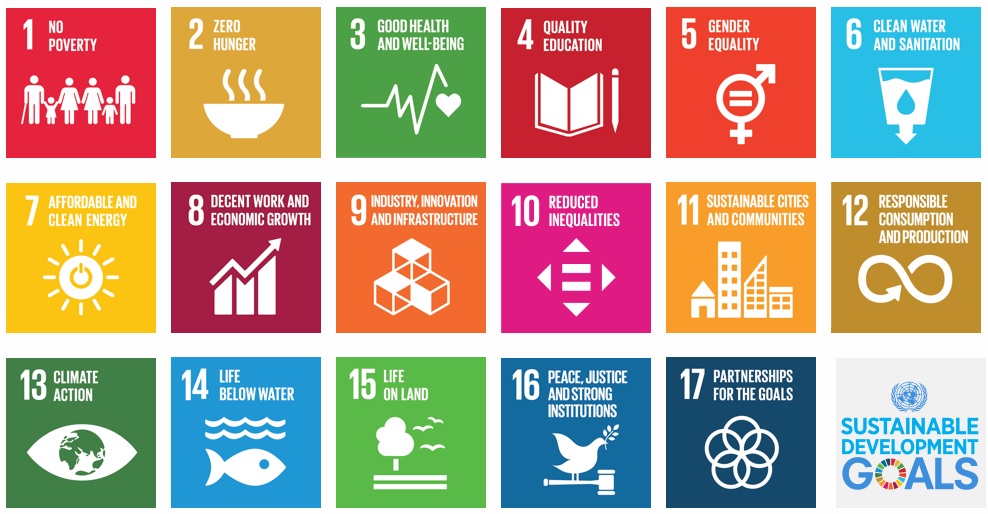WHAT ARE THE SUSTAINABLE DEVELOPMENT GOALS?


Partners
Institutional Alliance


Corporate Alliance

Association / Collaboration



While global poverty rates have been cut by more than half since 2000, one in ten people in developing regions are still living with their families on less than the international poverty line of US$1.90 a day, and there are millions more who make little more than this daily amount. Significant progress has been made in many countries within Eastern and Southeastern Asia, but up to 42% of the population in Sub-Saharan Africa continues to live below the poverty line.
Poverty is more than the lack of income and resources to ensure a sustainable livelihood. Its manifestations include hunger and malnutrition, limited access to education and other basic services, social discrimination and exclusion as well as the lack of participation in decision-making.
Economic growth must be inclusive to provide sustainable jobs and promote equality. Social protection systems need to be implemented to help alleviate the suffering of disaster-prone countries and provide support in the face of great economic risks. These systems will help strengthen responses by afflicted populations to unexpected economic losses during disasters and will eventually help to end extreme poverty in the most impoverished areas.
Facts And Figures
- 783 million people live below the international poverty line of US$1.90 a day
- In 2016, almost 10 per cent of the world’s workers live with their families on less than US$1.90 per person per day
- Globally, there are 122 women aged 25 to 34 living in extreme poverty for every 100 men of the same age group.
- Most people living below the poverty line belong to two regions: Southern Asia and sub-Saharan Africa
- High poverty rates are often found in small, fragile and conflict-affected countries
- One in four children under age five in the world has inadequate height for his or her age
- As of 2016, only 45% of the world’s population were effectively covered by at least one social protection cash benefit.
- In 2017, economic losses due to disasters, including three major hurricanes in the USA and the Caribbean, were estimated at over $300 billion.
It is time to rethink how we grow, share and consume our food. If done right, agriculture, forestry and fisheries can provide nutritious food for all and generate decent incomes, while supporting people-centered rural development and protecting the environment.
Right now, our soils, freshwater, oceans, forests and biodiversity are being rapidly degraded. Climate change is putting even more pressure on the resources we depend on, increasing risks associated with disasters, such as droughts and floods. Many rural women and men can no longer make ends meet on their land, forcing them to migrate to cities in search of opportunities. Poor food security is also causing millions of children to be stunted, or too short for the ages, due to severe malnutrition.
A profound change of the global food and agriculture system is needed if we are to nourish the 815 million people who are hungry today and the additional 2 billion people expected to be undernourished by 2050. Investments in agriculture are crucial to increasing the capacity for agricultural productivity and sustainable food production systems are necessary to help alleviate the perils of hunger.
Facts and Figures
- Globally, one in nine people in the world today (815 million) are undernourished
- The majority of the world’s hungry people live in developing countries, where 12.9 per cent of the population is undernourished.
- Asia is the continent with the hungriest people – two thirds of the total. The percentage in southern Asia has fallen in recent years but in western Asia it has increased slightly.
- Southern Asia faces the greatest hunger burden, with about 281 million undernourished people. In sub-Saharan Africa, projections for the 2014-2016 period indicate a rate of undernourishment of almost 23 per cent.
- Poor nutrition causes nearly half (45 per cent) of deaths in children under five – 3.1 million children each year.
- One in four of the world’s children suffer stunted growth. In developing countries, the proportion can rise to one in three.
- 66 million primary school-age children attend classes hungry across the developing world, with 23 million in Africa alone.
Food security
- Agriculture is the single largest employer in the world, providing livelihoods for 40 per cent of today’s global population. It is the largest source of income and jobs for poor rural households.
- 500 million small farms worldwide, most still rainfed, provide up to 80 per cent of food consumed in a large part of the developing world. Investing in smallholder women and men is an important way to increase food security and nutrition for the poorest, as well as food production for local and global markets.
- Since the 1900s, some 75 per cent of crop diversity has been lost from farmers’ fields. Better use of agricultural biodiversity can contribute to more nutritious diets, enhanced livelihoods for farming communities and more resilient and sustainable farming systems.
- If women farmers had the same access to resources as men, the number of hungry in the world could be reduced by up to 150 million.
- 4 billion people have no access to electricity worldwide – most of whom live in rural areas of the developing world. Energy poverty in many regions is a fundamental barrier to reducing hunger and ensuring that the world can produce enough food to meet future demand.
Ensuring healthy lives and promoting the well-being at all ages is essential to sustainable development.
Significant strides have been made in increasing life expectancy and reducing some of the common killers associated with child and maternal mortality, but working towards achieving the target of less than 70 maternal deaths per 100,000 live births by 2030 would require improvements in skilled delivery care.
Achieving the target of reducing premature deaths due to incommunicable diseases by 1/3 by the year 2030 would also require more efficient technologies for clean fuel use during cooking and education on the risks of tobacco.
Many more efforts are needed to fully eradicate a wide range of diseases and address many different persistent and emerging health issues. By focusing on providing more efficient funding of health systems, improved sanitation and hygiene, increased access to physicians and more tips on ways to reduce ambient pollution, significant progress can be made in helping to save the lives of millions.
Facts and Figures
Child health
- 17,000 fewer children die each day than in 1990, but more than five million children still die before their fifth birthday each year.
- Since 2000, measles vaccines have averted nearly 15.6 million deaths.
- Despite determined global progress, an increasing proportion of child deaths are in Sub-Saharan Africa and Southern Asia. Four out of every five deaths of children under age five occur in these regions.
- Children born into poverty are almost twice as likely to die before the age of five as those from wealthier families.
- Children of educated mothers—even mothers with only primary schooling—are more likely to survive than children of mothers with no education.
Maternal health
- Maternal mortality has fallen by 37% since 2000.
- In Eastern Asia, Northern Africa and Southern Asia, maternal mortality has declined by around two-thirds.
- But maternal mortality ratio – the proportion of mothers that do not survive childbirth compared to those who do – in developing regions is still 14 times higher than in the developed regions.
- More women are receiving antenatal care. In developing regions, antenatal care increased from 65 per cent in 1990 to 83 per cent in 2012.
- Only half of women in developing regions receive the recommended amount of health care they need.
- Fewer teens are having children in most developing regions, but progress has slowed. The large increase in contraceptive use in the 1990s was not matched in the 2000s.
- The need for family planning is slowly being met for more women, but demand is increasing at a rapid pace.
HIV/AIDS, malaria and other diseases
- 36.9 million people globally were living with HIV in 2017.
- 21.7 million million people were accessing antiretroviral therapy in 2017.
- 1.8 million people became newly infected with HIV in 2017.
- 940 000 people died from AIDS-related illnesses in 2017.
- 77.3 million people have become infected with HIV since the start of the epidemic.
- 35.4 million people have died from AIDS-related illnesses since the start of the epidemic.
- Tuberculosis remains the leading cause of death among people living with HIV, accounting for around one in three AIDS-related deaths.
- Globally, adolescent girls and young women face gender-based inequalities, exclusion, discrimination and violence, which put them at increased risk of acquiring HIV.
- HIV is the leading cause of death for women of reproductive age worldwide.
- AIDS is now the leading cause of death among adolescents (aged 10–19) in Africa and the second most common cause of death among adolescents globally.
- Over 6.2 million malaria deaths have been averted between 2000 and 2015, primarily of children under five years of age in sub-Saharan Africa. The global malaria incidence rate has fallen by an estimated 37 per cent and the mortality rates by 58 per cent.
Obtaining a quality education is the foundation to creating sustainable development. In addition to improving quality of life, access to inclusive education can help equip locals with the tools required to develop innovative solutions to the world’s greatest problems.
Over 265 million children are currently out of school and 22% of them are of primary school age. Additionally, even the children who are attending schools are lacking basic skills in reading and math. In the past decade, major progress has been made towards increasing access to education at all levels and increasing enrollment rates in schools particularly for women and girls. Basic literacy skills have improved tremendously, yet bolder efforts are needed to make even greater strides for achieving universal education goals. For example, the world has achieved equality in primary education between girls and boys, but few countries have achieved that target at all levels of education.
The reasons for lack of quality education are due to lack of adequately trained teachers, poor conditions of schools and equity issues related to opportunities provided to rural children. For quality education to be provided to the children of impoverished families, investment is needed in educational scholarships, teacher training workshops, school building and improvement of water and electricity access to schools.
Facts and Figures
- Enrolment in primary education in developing countries has reached 91 per cent but 57 million primary age children remain out of school.
- More than half of children that have not enrolled in school live in sub-Saharan Africa.
- An estimated 50 per cent of out-of-school children of primary school age live in conflict-affected areas.
- 617 million youth worldwide lack basic mathematics and literacy skills.
While the world has achieved progress towards gender equality and women’s empowerment under the Millennium Development Goals (including equal access to primary education between girls and boys), women and girls continue to suffer discrimination and violence in every part of the world.
Gender equality is not only a fundamental human right, but a necessary foundation for a peaceful, prosperous and sustainable world. Unfortunately, at the current time, 1 in 5 women and girls between the ages of 15-49 have reported experiencing physical or sexual violence by an intimate partner within a 12-month period and 49 countries currently have no laws protecting women from domestic violence. Progress is occurring regarding harmful practices such as child marriage and FGM (Female Genital Mutilation), which has declined by 30% in the past decade, but there is still much work to be done to complete eliminate such practices.
Providing women and girls with equal access to education, health care, decent work, and representation in political and economic decision-making processes will fuel sustainable economies and benefit societies and humanity at large. Implementing new legal frameworks regarding female equality in the workplace and the eradication of harmful practices targeted at women is crucial to ending the gender-based discrimination prevalent in many countries around the world.
Facts and Figures
- Globally, 750 million women and girls were married before the age of 18 and at least 200 million women and girls in 30 countries have undergone FGM.
- In 18 countries, husbands can legally prevent their wives from working; in 39 countries, daughters and sons do not have equal inheritance rights; and 49 countries lack laws protecting women from domestic violence.
- One in five women and girls, including 19 per cent of women and girls aged 15 to 49, have experienced physical and/or sexual violence by an intimate partner with the last 12 months. Yet, 49 countries have no laws that specifically protect women from such violence.
- While women have made important inroads into political office across the world, their representation in national parliaments at 23.7 per cent is still far from parity.
- Only 52 per cent of women married or in a union freely make their own decisions about sexual relations, contraceptive use and health care.
- Globally, women are just 13 per cent of agricultural land holders.
- More than 100 countries have taken action to track budget allocations for gender equality.
- Women in Northern Africa hold less than one in five paid jobs in the non-agricultural sector. The proportion of women in paid employment outside the agriculture sector has increased from 35 per cent in 1990 to 41 per cent in 2015.
- In 46 countries, women now hold more than 30 per cent of seats in national parliament in at least one chamber.
- In Southern Asia, a girl’s risk of marrying in childhood has dropped by over 40% since 2000.
- The rates of girls between 15-19 who are subjected to FGM (female genital mutilation) in the 30 countries where the practice is concentrated have dropped from 1 in 2 girls in 2000 to 1 in 3 girls by 2017.
